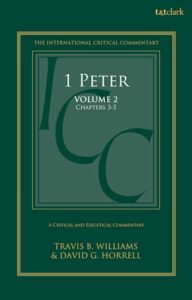Review of 1 Peter (ICC) by Williams and Horrell (Part 2)
This post continues (see Part 1 here) a review of the new, two-volume commentary in the ICC series by Travis Williams and David Horrell. In this post on Volume 2, we will examine the exegesis of a few debated passages in chapters 3–5, the chapters covered in this volume. We will first explore the authors’ understanding of the roles of husbands and wives in 3:1–7, then examine the identity of the spirits who were preached to in 3:19–20, and finally, look at the commands to elders in 5:1–4. The authors’ contribution to the scholarly study of 1 Peter is the primary strength of the commentary. The extensive exegetical work will no doubt aid those seeking to interact with the primary and secondary sources of 1 Peter.
As with the first volume the authors outline the book and exegete each unit. Each section begins with an initial bibliography used for the research of that section. The next section includes the authors’ Greek text, which follows their conclusions on the textual variants in the passage. The next section covers those textual variants. These textual discussions are usually two pages or more. Following the textual section, the authors begin a clause-by-clause analysis. This formatting helps locate the explanations within the larger unit. The authors conclude each unit with a summary section that contains their application and relevance for modern audiences. This last section is limited, usually only a few pages. Most of the commentary is given over to the exegesis of the text.
While the authors strive for objectivity, their critical perspectives heavily influence their interpretation of Scripture. For instance, in their interpretation of Peter’s instructions to wives, the authors suggest that viewing the text as authoritative is, at best, a risky proposition (77). The authors understand the connection between the slaves and wives as if the wife is called into the same role as the slave (75). More likely, the parallel is that both are in a subordinate role. The authors suggest that the instructions to wives to stay committed to an unbelieving husband should be disbanded amid any threat of violence (75). The authors seem to stand in judgment over the text as they lament that this teaching does not “express a conviction about the essential equality of women and men” (75). They believe that the teaching on gender roles in 1 Peter “is patriarchy: a moderate, considerate form of patriarchy, but patriarchy nonetheless” (77). This approach is admittedly a common view in scholarship today.
Readers will also be interested in how the authors identify the “spirits in prison” (3:19) and the content of the message preached to them. The discussion on verse 19 stretches to about 30 pages and is thorough. Williams and Horrell work hard to demonstrate that the lexical data does not rule out the spirits being dead humans or fallen angels. However, they also do a good job showing that the evidence for either view is not as clear-cut as some commentaries make it out to be. They devote a few pages to the theory that Peter references Noah’s preaching to those alive during his time. Augustine championed this view. Williams and Horrell reject this in agreement with most of the literature on the topic. The authors spend considerable time on the recipients and their location. Ultimately, they decide that the spirits are the souls of dead humans in the afterlife. They cite the Greek teaching of Hades as evidence of a holding place in the spirit realm. This understanding would have been common in the broader culture of Greek mythology at the time of composition. One aspect of the topic they give less attention to is the content of what was preached. The two primary options are (1) the gospel message or (2) a message regarding the victory of Christ. The authors conclude that the gospel was preached to the dead human spirits because the gospel message was the only type of message Jesus preached during his ministry (241). Thus, any other message would be a departure from the normal pattern of Jesus’ teachings. However, this is a reductionist view of the ministry of Jesus. For example, in the gospels, Jesus pronounced judgment on those who disobeyed his word (Matt 23:13). The authors also fail to answer the objection many have raised regarding whether or not those who receive this message are given a second chance to believe.
The identity of the elders in 5:1 is often understood as a reference to the pastors of the churches to whom Peter is writing. However, Williams and Horrell understand this to be senior church members and not a reference to a specific office (506). They argue that Hellenistic and Judaistic cultures had the same position in their religious and civic communities. In those contexts, elders were often leaders because of their social status and age. Thus, they assumed leadership responsibility in the religious institutions because of their status in the community. This leads the authors to conclude that the elders Peter addresses occupy a similar role as leaders, not a specific church office (504). They claim that “there is no mention of elders within the undisputed Pauline letters” (503). Of course, the counterargument is that Paul gives qualifications for elders not only in 1 Timothy 3 and Titus 1 but also addresses elders in his undisputed letter to the church at Philippi (Phil 1:1).
The commentary on 1 Peter by Travis Williams and David Horrell is strong in the breadth of exegetical discussion and in the notes on the text. Though conservative readers will find faults, the commentary set will undoubtedly aid pastors and scholars in studying 1 Peter. So, with those caveats in mind, I recommend the set as a good addition to a pastor’s library.



